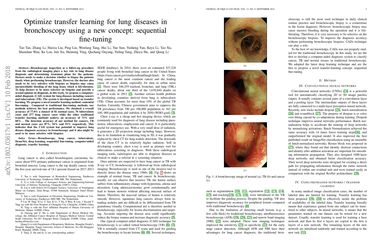Optimize transfer learning for lung diseases in bronchoscopy using a new concept: sequential fine-tuning
Bronchoscopy inspection as a follow-up procedure from the radiological imaging plays a key role in lung disease diagnosis and determining treatment plans for the patients. Doctors needs to make a decision whether to biopsy the patients timely when performing bronchoscopy. However, the doctors also needs to be very selective with biopsies as biopsies may cause uncontrollable bleeding of the lung tissue which is life-threaten. To help doctors to be more selective on biopsies and provide a second opinion on diagnosis, in this work, we propose a computer-aided diagnosis (CAD) system for lung diseases including cancers and tuberculosis (TB). The system is developed based on transfer learning. We propose a novel transfer learning method: sentential fine-tuning . Compared to traditional fine-tuning methods, our methods achieves the best performance. We obtained a overall accuracy of 77.0% a dataset of 81 normal cases, 76 tuberculosis cases and 277 lung cancer cases while the other traditional transfer learning methods achieve an accuracy of 73% and 68%. . The detection accuracy of our method for cancers, TB and normal cases are 87%, 54% and 91% respectively. This indicates that the CAD system has potential to improve lung disease diagnosis accuracy in bronchoscopy and it also might be used to be more selective with biopsies.
PDF Abstract
